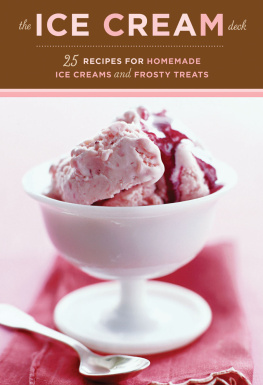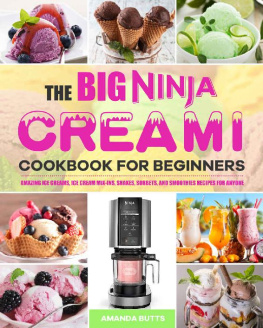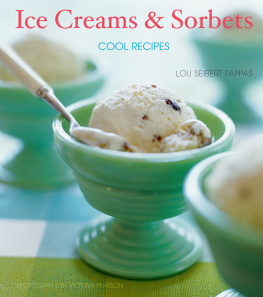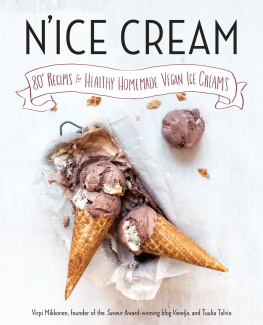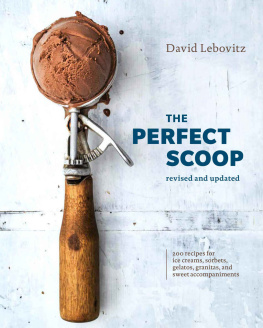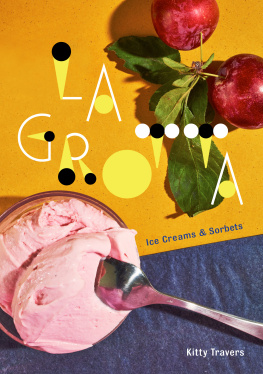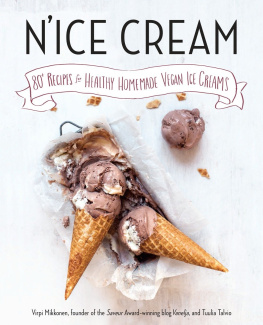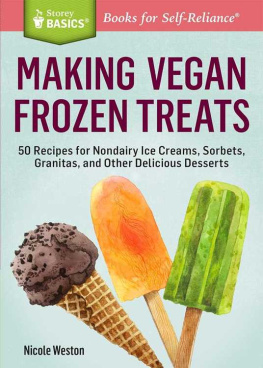It goes without saying that a great dessert tastes delicious, but it also satisfies on other levels, whether because its beautiful, evokes a memory, or makes you smile in appreciation of its simplicity. And no desserts seem to do that as well as those involving ice cream.
What is even more satisfying is creating your own frozen treats. With todays efficient equipment, ice cream can be churned in little more than a quarter of an hour, which means that in next to no time, you can achieve silky, satiny ice cream creations unadorned with additives. Recent years have also seen an amazing increase in both the variety and availability of high-quality, store-bought ice cream. And although its hard to improve on the simplicity of a bowl of good ice cream, just a few deft additionsa fruit topping, a crumb crust, a chewy gingersnap, or a layer of butter caketurn ice cream into a special and evocative dessert.
The recipes in this deck will show you how to make your own ice cream and how to use homemade or purchased ice cream to make cakes and pies, ice cream sandwiches, sundaes, layered parfaits, and drinks that range from homey to elegant. Go ahead and indulge, and use your imagination to come up with your own creations.
MAKING ICE CREAM
Ice cream is basically a liquid mixture that is stabilized by freezing much of the liquid and creating a very fine crystalline structure. Three stages are involved in the preparation of frozen desserts: preparing the mix, freezing it, and ripening (or firming) it after the freezing process. To achieve a fine consistency, several factors are important: proper agitation, rapid freezing, and incorporating the proper amount of air.
It is useful to understand the science behind the freezing process. Sugar lowers the freezing point of the liquid solution from 32F to around 27F. The dissolved sugar gets in the way of the water molecules that would otherwise bond to form ice crystals. Instead, as they crystallize, water molecules are removed from the mixture, the remaining solution gets more concentrated with sugar, and the freezing point is lowered further.
Therefore, to achieve a fine-quality product, ice creams and sorbets must have many well-dispersed tiny ice crystals. While much of the water in the mixture freezes, the concentration of sugar and other substances prevents the dessert from fully solidifying. Cream, milk, and eggs work as buffers to separate the tiny crystals from one another. In addition, liquor, liqueurs, wine, honey, and corn syrup further lower the freezing point of the mixture, so frozen desserts made with them will usually be softer.
Another influence on the ultimate texture of ice cream is the amount of air whipped in. When the mixture churns in an ice cream maker, air beaten in also helps keep the ice crystals apart and makes the texture smooth. As home freezers churn, the majority of the aeration happens toward the end of the processing time, producing desirably-tiny air pockets.
In addition, rapid cooling of the mix while stirring develops many small seed ice crystals and helps to distribute them evenly. Ultimately, the more agitation provided, the slower the freezing process, and the tinier the ice crystals.
Manufacturers offer ice cream makers to suit every budget. If the ice cream maker is the type that needs to be packed with ice and salt, rock salt is essential. A good proportion of ice to rock salt is 8 parts ice to 1 part salt, by measure. Otherwise, ice cream should be made according to the manufacturers instructions for the ice cream maker.
After being frozen in an ice cream maker, ice cream is usually placed in the freezer for 2 hours to firm up, or ripen. This allows the flavors to blend. Ideally, ice cream should be stored at fairly low temperatures, between10F and 0F, to maintain its fine texture and flavor. Cover it tightly so it doesnt pick up odors and so that moisture does not settle onto its surface, forming large crystals. The gradual coarsening of texture during freezing is due to repeated partial thawing when serving or from fluctuations in the temperature of the freezer.
BUYING ICE CREAM
When buying ice cream at the supermarket, there are basically two kinds to choose between: premium and nonpremium. Although these denominations sound like they indicate quality, its more accurate to say they indicate the style of the ice cream, and which you choose is largely a matter of personal preference. Premium ice cream (brands like Hagen-Dazs, Ben & Jerrys, and Dreyers Dreamery) is most often sold by the pint, and is denser and richer than nonpremium ice cream. This is because it contains more solids and less air than nonpremium ice cream. Premium ice cream is therefore more expensive, and it contains nearly twice the calories and fat of nonpremium ice cream.
Because nonpremium ice cream has more air, it softens more evenly and is easier to spread. However, for the same reason, it also melts faster. This can lead to iciness in a finished dessert if the ice cream melts too much as you work.
Some of the recipes in this deck call for 2 pints premium or 1 quarts nonpremium ice cream. This is because nonpremium ice cream tends to pack down more when you soften and spread it. In an ice cream cake, 2 pints of premium ice cream will look like about the same volume as 1 quarts of nonpremium.
A few of these recipes specify one type or the other. If the recipe does not specify a particular type, either will work.
TIPS AND TOOLS FOR PERFECT ICE CREAM TREATS
Check to make sure you have adequate room in your freezer for what you plan to make. You dont want to assemble a beautiful ice cream dessert only to have it melt while you make space for it in the freezer.
Have your workspace clear and your tools and ingredients on hand before taking the ice cream out of the freezer to minimize the time the ice cream spends at room temperature. Try to work with ice cream in a cool kitchen rather than in a kitchen warm from the midday heat or the oven.
SOFTENING TIPS
For sundaes, parfaits, and ice cream sandwiches, ice cream need only be soft enough to scoop easily. For making ice cream cakes and pies, however, you want your ice cream to be soft enough to spread, but not so soft that it melts as you work. The easiest way to soften ice cream evenly is to microwave the carton on full power at 10-second intervals for up to about 40 seconds, stopping every 10 seconds to stir or break up the ice cream with a knife or spatula so that the outside doesnt melt before the center softens. You can also let the ice cream stand at room temperature for 10 to 15 minutes, stirring it occasionally to encourage even softening.
Keep in mind that nonpremium ice cream will soften more quickly than premium ice cream because it has more air, and that sorbet, because of its high sugar content, will soften even more quickly.
STORING
One of the greatest advantages of many of the ice cream desserts in this deck is that they can be assembled several days ahead of time. Each recipe has individual storage guidelines, but a few general principles apply:
- Depending on how cold your freezer is, it is a good idea to turn it to the coldest setting.
- Try to serve homemade sorbets and frozen yogurts within one to two days from the time they are made, which is when they will have the best texture. With longer storage, the smooth texture develops larger ice crystals.
- Before freezing, wrap ice cream treats well in plastic wrap when called for, to prevent ice crystals from forming. Note that ice cream made with a cooked egg custard will keep its texture longer, for several days or up to a week.
SERVING TIPS

